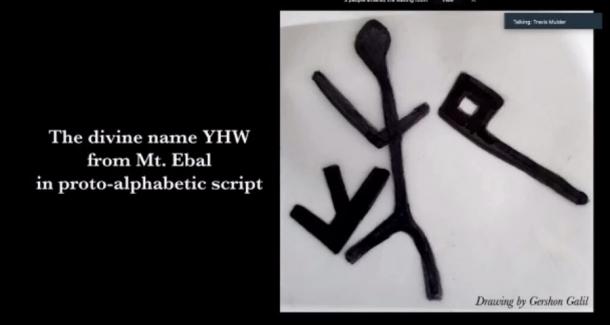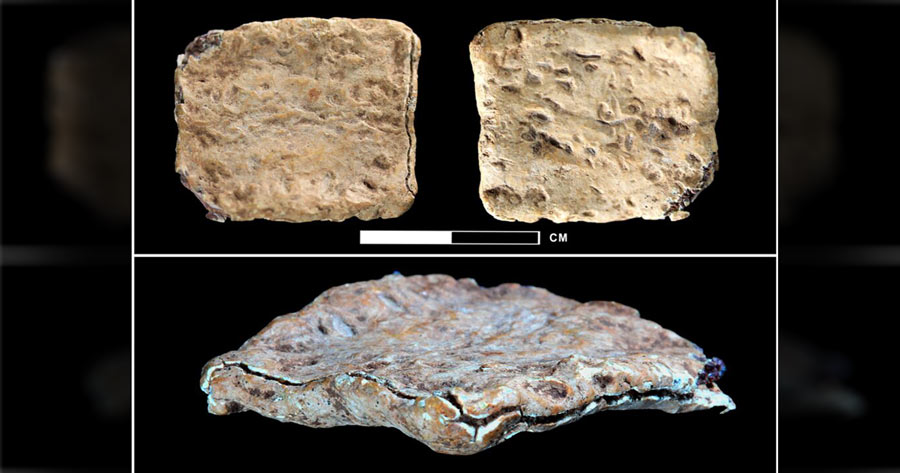Curse Tablet Found on Mount Ebal Suggests Early Literacy Came to Israel
One of two mountains in the West Bank, Mount Ebal occupies a special place in the hearts and mythology of the Israelites, but not in the most positive light. In advance of the entry of the Jews into the ‘Promised Land’, one of the holy texts (Deuteronomy 11:29) quotes Moses as advising the Israelites to put the curse on Mount Ebal. Joshua was also believed to have built an altar here after the Battle of Ai, and in relation to that, experts from the Associates for Biblical Research (ABR) claim to have deciphered an ancient curse from a lead tablet from excavations there, reports Haaretz.
Initially discovered in December, 2019 under the tutelage of Scott Stripling, ABR’s director of excavations, the tablet was found in a pool of discarded material taken from the excavations of Israeli archaeologist Adam Zertal, who had spent much of the early and mid-1980s digging on ‘Curse Mountain’. The tablet is inscribed with 40 ancient Hebrew letters, with preliminary dating placing it to the Late Bronze Age – 14th to 13th century BC!
- New Analysis of Ancient DNA Proves that Canaanites Survived Biblical Massacre
- The Wolves of Dacia Take On the Roman Empire

Dr. Scott Stripling during pottery reading at the Mount Ebal altar site in 2019. (Michael C. Luddeni / Armstrong Institute)
A Tablet Tough to Reconstruct
This 3,200-year-old neatly folded Aegean lead tablet was found buried near the city of Shechem in Samaria at Mount Ebal, and had letters in the proto-Canaanite script, containing the formulaic curse (called defixio) which was deciphered using high-tech scanners. Another way of deciphering it would be to understand it as Sinaitic script, with the hex text being early Israelite, according to the team.
The metal initially was too brittle to unfold, forcing the ABR team to contact researchers in Prague who used tomographic scans (akin to a medical diagnostic CT scan) to recover the potentially lost text. The lead was analyzed at Hebrew University by Professor Naama Yahalom-Mack, and found that it is consistent with ore from Greece. Lead from Greece has been found at other late Bronze Age and early Iron Age sites in this region, so this is not surprising. Tablets with curses are associated with later periods.
If the claims are indeed correct, this tiny 2 cm x 2 cm (0.78 x 078 inch) curse tablet can potentially be seen as one of the greatest archaeological discoveries ever, reports Israel Hayom. It would be proof of the first used name of ‘the Lord’ in the ‘Promised Land’ and set the perceived age of literacy back by several centuries.
- The Walls of Jericho: How Accurate Was The Biblical Account?
- Unique Biblical “Persimmon” Amethyst Seal Discovered In Jerusalem Sewer

Slide from the press conference featuring proto-alphabetic script of the Israelite name for God: YHW (Gershon Galil / Youtube Screenshot)
Early Representation of Jehovah
It is also the earliest such artifact to feature the Tetragrammaton, the four-letter name of God. In exact terms, one can argue that this a reference to Jehovah or Yahweh, represented by the letters YHWH (or JHVH). In exact terms, the following was written on the tablet:
“Cursed, cursed, cursed - cursed by the God YHW.
You will die cursed.
Cursed you will surely die.
Cursed by YHW – cursed, cursed, cursed.”
A researcher from Haifa University explained the inscription’s formulaic literary structure suggested that it was written as a ‘chiastic parallelism’, wherein a literary structure known in the Psalms with consecutive phrases, repeats the same grammatical structure.
This opens up the idea that the Israelis were literate when they entered Israel and could have potentially written the Bible, since a few events that were documented actually did take place, in historical terms. “Everything we know about Mt. Ebal comes from the Bible,” Stripling added at a press conference hosted on Thursday.
Precautionary archaeological indicators suggest that a peer-reviewed academic process of publishing is required before ascertaining how old and how valid this find is. Certain academics suggest that this makes this find a “bit off” or symptomatic of an overdeveloped imagination. However, in archaeology and science, the processes of proof are slow which means that this could yet be a landmark find in the history of Biblical and Judaist writings.
“These types of amulets are well known in the Hellenistic and Roman periods, but Zertal’s excavated pottery dated to the Iron Age 1 and Late Bronze Age, so logically the tablet derived from one of these earlier periods. Even so, our discovery of a Late Bronze Age inscription stunned me,” said Stripling in the press conference. An academic, peer-reviewed article is in the pipeline and will be published later in the year.
Top image: The lead curse tablet found on Mount Ebal. Source: Michael C. Luddeni | Associates for Biblical Research (ABR)
By Sahir Pandey
References
Schuster, R. 2022. Early Israelite Curse Inscription Found on Mt. Ebal. Available at: https://www.haaretz.com/archaeology/.premium-early-israelite-curse-inscription-found-on-mt-ebal-1.10696926.
Forsher, E. 2022. 'Artifact is testament to Jewish people's deep connection to Samaria'. Available at: https://www.israelhayom.com/2022/03/25/earliest-hebrew-artifact-bearing-gods-name-found-in-israel-archaeologists-say/.



















